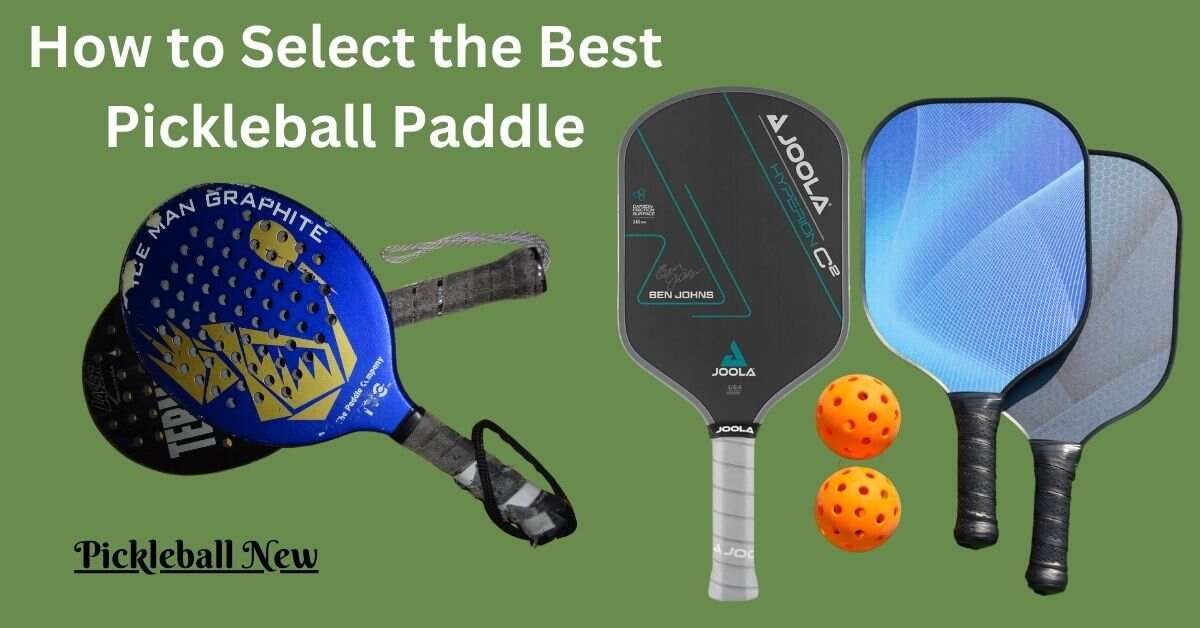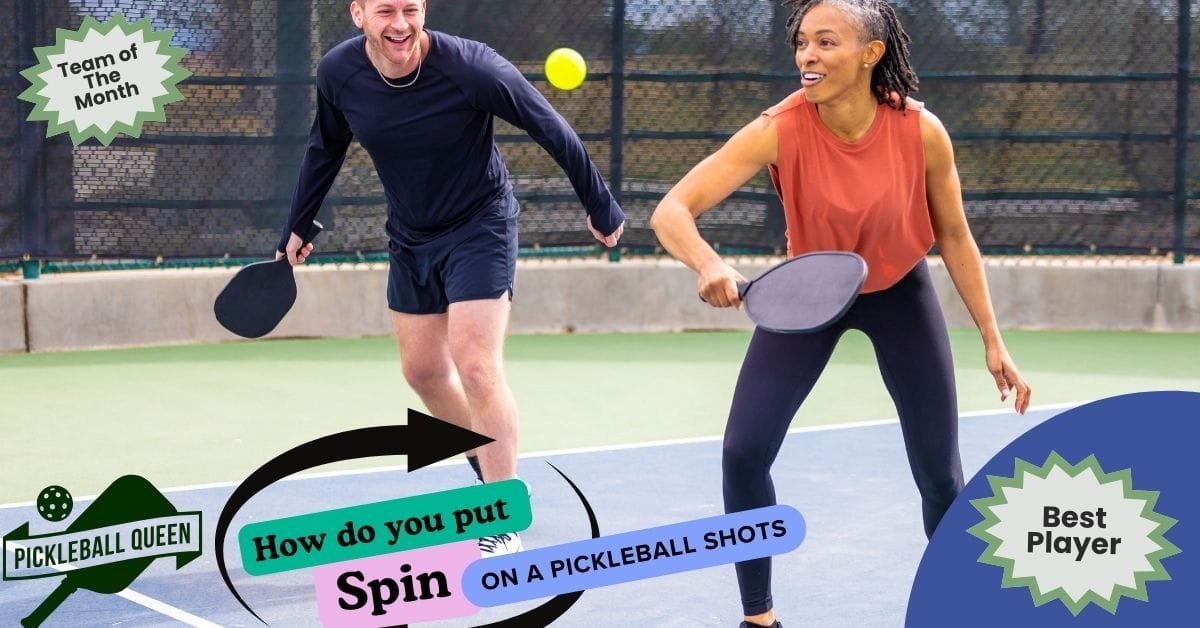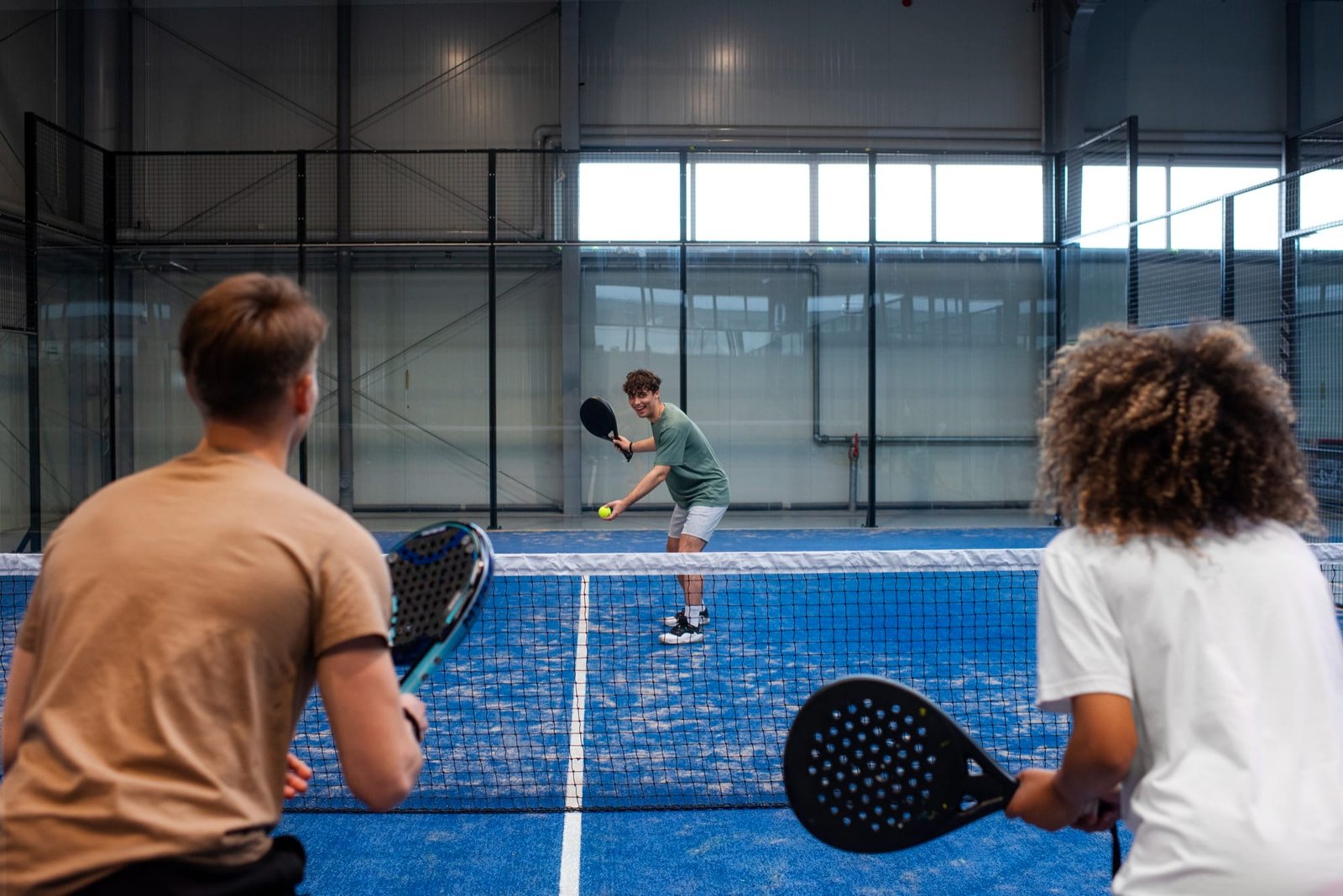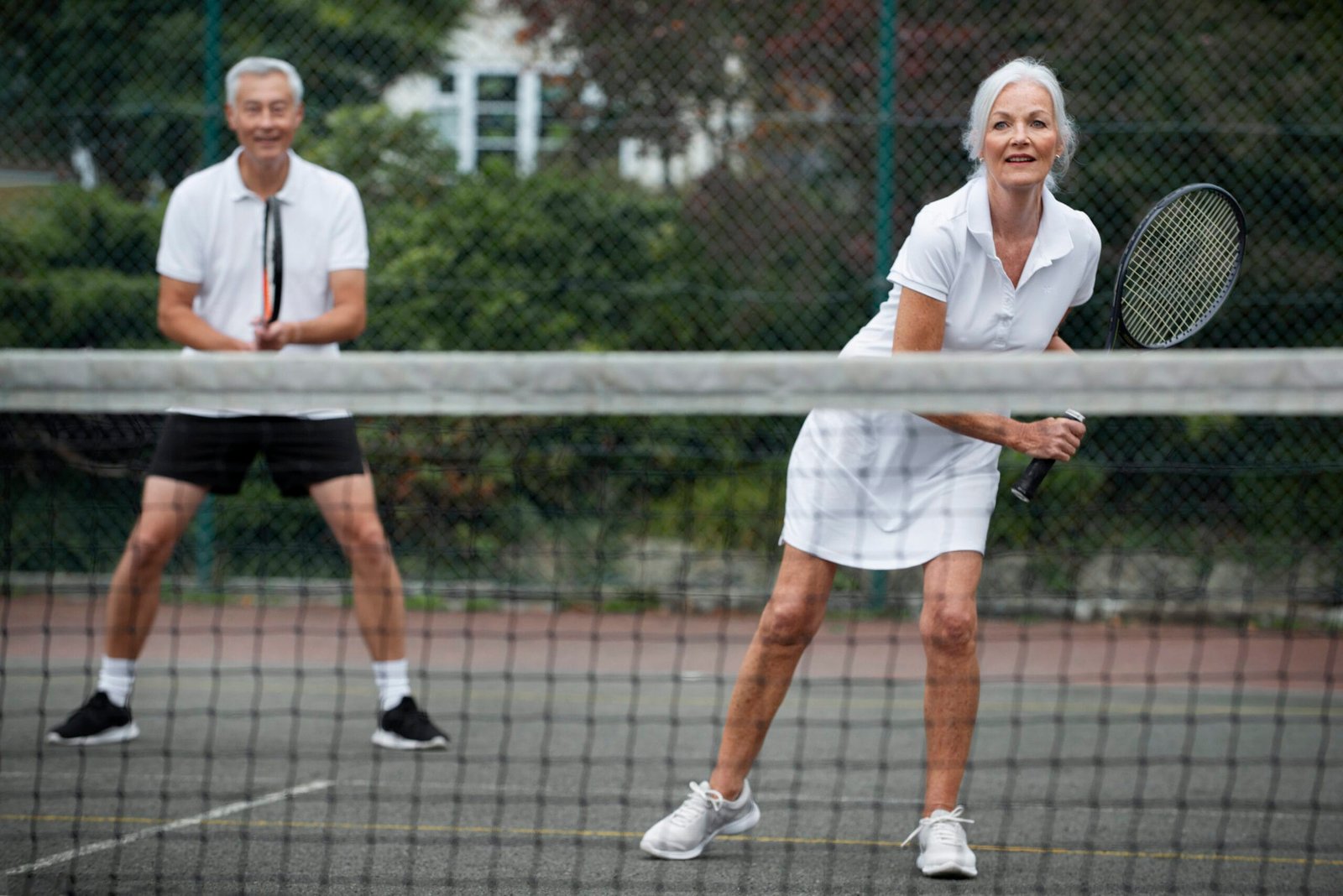How to Select the Best Pickleball Paddle for Your Game in 2024

Pickleball, a fast-paced and exciting sport, requires the right equipment for optimal performance. For beginners, selecting the best pickleball paddle is crucial for an enjoyable playing experience. From measure to shape to weight, you’ll learn the ins and outs of choosing the culminate paddle to assist you in overwhelming the court.
So, prepare to take your pickleball amusement to another level, and let’s start! This guide easily breaks down the critical aspects of paddle selection, ensuring that even intermediate players can make informed decisions.
Choosing the best pickleball paddle involves various factors. By understanding your preferences, skill level, and the features of different paddles, you can make an informed decision to enhance your playing experience.
How to Select Pickleball Paddles?
Choosing the best pickleball paddle can be challenging because numerous factors exist, such as grasp estimate, weight, and center fabric. The least demanding approach to choosing a paddle is to test them out, as shifted weights and hold sizes will modify your playing fashion. Choosing a paddle that’s inside your quality level and dodges unreasonably overwhelming paddles is basic. Tennis-style grasps are too suggestive for pickleball paddles.
Most players will be drawn to middleweight paddles (7.0-7.4oz), even though lightweight paddles may be more suited for individuals who have, as of now, played ping pong or racquetball. It is additionally essential to guarantee that the player favors the feel of the paddle.
Key Factors to Consider When Choosing a Pickleball Paddle

Choosing the correct pickleball paddle can be an overwhelming assignment! It would be best if you created beyond any doubt you select the proper one for your playing fashion and aptitude level. Here are some essential components to consider when choosing the best pickleball paddle for you:
Paddle shape.
Pickleball paddles come in a variety of shapes and sizes. There’s something for everyone, whether you are a or a progressed player. When it comes to pickleball paddles, measure things. A giant paddle will give you a more significant sweet spot and more control, whereas a little paddle will give you more control. Find a paddle estimate that’s comfortable for your height and arm length.
But shape is as vital as measure! Adjusted paddles are extraordinary for fledglings as they offer more absolution. Ex-tennis or badminton players will adore them as they are the closest shape to a conventional tennis racquet. Tear paddles, on the other hand, provide more control and turn. The foremost typical shape for a pickleball paddle is the wide-body plan, which maximizes the measurements permitted by the official rules of Pickleball.
Other plans incorporate prolonged paddles, which are longer than 16 inches, and include a narrower confrontation but a longer paddle length. You, too, have to be the paddle’s grasp estimate – a more significant grasp makes a difference in keeping up control, whereas a more minor hold is superior for control and spin.
So, what’s the proper measure and shape for you? Explore with distinctive paddles to discover the one that fits you best!
Paddle weight.
When selecting a pickleball paddle, weight becomes an indispensable factor that must be pondered upon. The paddle’s weight can significantly influence your game and overall performance while occupying the court. It is generally observed that pickleball paddles exhibit weights ranging from 6 to 14 ounces. This weight magnitude affects your capacity to command your shots and adroitly manipulate the paddle.
Lighter paddles offer enhanced maneuverability, allowing players to react swiftly to fast-paced rallies. The trade-off, however, lies in power. Understanding how lightweight paddles excel in control-oriented play is crucial for players prioritizing finesse over raw power.
Choosing the correct pickleball paddle is fundamental for moving forward with your diversion. The weight and adjustment of a paddle can make all the distinction!
Start by selecting a paddle that’s comfortable to hold. You do not need it to be too heavy or too light. A great way to run the show of thumb is to discover a paddle that weighs between 7 and 9 ounces.
At the other end of the spectrum, heavy paddles generate more power and stability during shots. This weightier option caters to players who rely on solid and aggressive strokes. However, control might be sacrificed, requiring players to find the delicate equilibrium between power and precision.
Middle-weight paddles aim to balance the advantages of both light and heavy counterparts. Players seeking an all-encompassing solution often gravitate towards these paddles, leveraging a blend of control and power.
Ultimately, securing the optimal weight for your pickleball paddle hinges upon factors encompassing individual playing style preferences and personal strength capabilities.
- A lighter paddle allows for enhanced agility and quick response time.
- Lighter paddles favor players relying on agile reflexes and fast-paced gameplay.
- Heavier paddles provide additional power and stability during shots.
- The extra mass in a heavier paddle allows for increased momentum generation.
- Controlling and swinging a heavier paddle may require more physical strength and effort from the player.
- Finding the optimal weight for your pickleball paddle depends on individual playing style preferences and personal strength capabilities.
Weighted Classes of Pickleball Paddles
There are three different weight classes for pickleball paddles. They are categorized as follows:
Pickleball paddles come in a run of weights, from light to overwhelming. Light paddles are fantastic for players who require more manoeuvrability, whereas heavier paddles are way better for power players.
Length of the handle.
Paddles are measured from the bottom of the butt cap to the top of the edge guard. This means a paddle with a shorter handle can have a larger hitting surface. A more extended handle will have a smaller hitting surface to stay within the 24-inch maximum dimension.
A critical paddle component is the handle’s length, which directly impacts playability. Handle length affects where the sweet spot sits on the paddle and how much hitting surface the paddle has.
Grip Size:
Another critical calculation to consider is the measure of grasp. The connection between the player and the paddle is established through the grip. Exploring various grip styles and materials allows players to find the perfect balance between comfort and control.
Round handles are the most well-known, as they provide a comfortable grasp for your whole hand. Conversely, tapered handles are more common on proficient quality paddles and give a distant better, much better, higher, more robust, and improved fit for your fingers.
- A comfortable grip on your pickleball paddle is essential, with your fingers not hanging off the end.
- The correct grip size for pickleball paddles is typically measured at the center of the handle and ranges from 4 to 5 inches.
- These are commonly used methods to determine the appropriate grip size, such as using a known tennis racquet grip size or measuring your hand from the tip of your ring finger to the middle crease of your palm.
- Finding the right weight and adjusting your pickleball paddle can significantly impact your performance, so don’t hesitate to try different models until you find the perfect fit.
- A comfortable grip is crucial for maintaining consistent performance on the court, and this section explores various methods for determining the ideal grip size based on factors like hand size and playing style.
Most paddles come in three hold sizes: small, medium, and expansive. Little holds are best for kids, whereas medium and enormous are regularly more comfortable for adults.
Evaluating the Materials Utilized in Paddles
Pickleball paddles are made of either graphite, composite, or wood. Graphite paddles are extraordinary for turn and control, while composite paddles offer an adjustment of control and control.
Core material.
When it comes to pickleball paddles, one of the foremost vital choices you can make is what fabric you need the paddle to be made of. While a few significant materials are utilized to create paddles, each has its aces and cons.
The Core: Polymer vs. Nomex
In pickleball paddles, the core material plays a pivotal role. Understanding the differences between polymer and Nomex cores is essential for making an informed decision. Each material has unique characteristics, influencing power, control, and touch.
Face material.
Face Material: Graphite vs. Composite
Delving into the surface of the paddle, the choice between graphite and composite faces introduces another layer of complexity. The material composition affects the paddle’s responsiveness and durability, catering to different playing styles.
Grip Material:
Most paddles are rubber or foam; elastic holds offer more consolation, whereas froth handles give a more secure hold. Which grasp and handle fashion is proper for you? Attempt out some distinctive paddles to find the one that fits your game!
surface material and thickness
A pickleball paddle’s surface material and thickness are crucial to its performance. Wooden paddles, while still available, have more minor sweet spots and are generally less durable. Go for paddles made of composite materials, graphite, or carbon fiber is recommended. These materials provide stiffness, lightness, and durability.
Additionally, paddles with a honeycomb core design are known to absorb the ball’s impact and offer better control.
Price:
Of course, the paddle’s cost is an imperative calculation to consider. You do not have to break the bank to discover a good paddle, but do not hold back on quality either! So, you have four fundamental components to consider when choosing the best pickleball paddle! Can you think of any others? Let us know in the comments below!
Here is a handy Price Comparison Chart for different materials and brands of paddles:
| BRAND | MATERIAL | BEGINNER | INTERMEDIATE | ADVANCED |
| Onix | Wood | $30-60 | $60-90 | $90-120 |
| Selkirk | Composite | $60-80 | $80-110 | $110-170 |
| Paddletek | Graphite | $80-110 | $110-170 | $160-230 |
| Engage | Aluminum | $60-80 | $80-120 | $120-170 |
| Gamma | Fiberglass | $60-90 | $80-125 | $110-180 |
Understanding the Diverse Sorts of Pickleball Paddles

Composite Paddles:
Composite paddles are the cheapest and give good power and control. The drawback is that they are not final as long as aluminum or graphite paddles. If so, which fabric should you select? It depends on your budget and your playing fashion. If you want a lightweight paddle with great control, aluminum is probably your best wager.
If you’re seeking significant adjustment of control and control, graphite is your best alternative. And if you’re looking for a cheap paddle that will still give you great control, composite is the way to go. No matter what fabric you choose, you’re beyond any doubt to discover a paddle that fits your needs and your budget!
Benefits of Composite Paddles
- Composite paddles have gained immense popularity in pickleball due to their unique characteristics.
- These paddles are made from a combination of materials, typically fiberglass and polymer.
- The durability of composite paddles is a standout feature, as they can withstand heavy use without showing signs of damage.
- The construction of these paddles involves blending different materials, resulting in a solid composition.
- Even with frequent usage and rough handling on the pickleball court, composite paddles can endure for extended periods.
- In addition to their durability, composite paddles offer exceptional control and extraordinary power.
- The combination of fiberglass and polymer perfectly balances precise manipulation and hitting solid power.
- Holding a composite paddle in your hand will give you a sense of confidence and finesse as you dominate the court.
Wood Paddles:
These paddles are frequently made from maple, birch, or basswood and are often lighter and more manoeuvrable than composite paddles. They usually have a smaller sweet spot, making them superiorly suited for experienced players.
Why Wood Paddles Could Be a Good Option
- Wood paddles have always been the go-to choice for pickleball players due to their exceptional durability.
- Unlike composite or graphite paddles, wood can withstand regular use without breaking or chipping.
- Wood paddles have a unique burstiness that sets them apart from other materials.
- Holding a wooden paddle evokes a sense of tradition and timelessness, enhancing the overall playing experience.
- The captivating sounds of wood paddles when they meet the ball, add a layer of fascination to every play.
Graphite/Carbon Fiber Paddles:
Graphite paddles are lightweight and provide a remarkable adjustment of control and control. They’re, moreover, the foremost prevalent paddle material.
These paddles are ordinarily made from graphite or carbon fiber and offer control and touch.
Advantages of Graphite Paddles
- Graphite paddles are very popular in pickleball because they have many advantages.
- One of the main benefits is that they are lightweight, which makes them easier to handle.
- The graphite material used to make these paddles is lighter than wood or composite materials, which allows players to move the paddle quickly and have better control over their shots.
- Another advantage of graphite paddles is that they can prevent fatigue during long matches so players can maintain their performance for longer.
- Graphite paddles are also durable and can withstand intense play and weather conditions, making them suitable for outdoor games.
The Benefits of Carbon Fiber Paddles
Furthermore, carbon fiber paddles have become renowned for their extraordinary power and shot accuracy.
In summation, carbon fiber paddles present an alluring amalgamation of lithe design, authoritative mightiness, and unerring precision. These coveted implements enjoy immense popularity amongst pickleball enthusiasts who place the utmost value on velocity control and surgical exactitude within their gameplay.
Aluminum pedals:
Aluminium pedals are light and give great control. The disadvantage is that they are the most expensive type of pedal. Aluminum-core pickleball paddles are a particular type of paddle designed with an aluminum core to offer players better performance on the court.
Compared to other materials, the thickness of the aluminium core in a pickleball paddle is typically greater, serving as a protective measure against the unavoidable wear and tear caused by repeated gameplay. The construction begins by enclosing the aluminium core within two layers of top-notch surface material. This meticulous procedure guarantees that the paddle retains its structural honesty while maintaining a lightweight design.
Aluminum-core pickleball paddles offer a remarkable blend of strength, control, power, and longevity, rendering them an ideal choice for players at any skill level. The heightened rigidity of the aluminum core plays a pivotal role in enhancing the power behind your shots while ensuring exceptional ball control. Moreover, this characteristic also amplifies the spin potential, enabling you to effortlessly apply more topspin or slice to each shot, thereby keeping your opponent on their toes and uncertain of your next move.
Pickleball Paddle Edge Assurance Options
Pickleball paddles come in all shapes and sizes, but one of the most critical highlights of a paddle is edge protection. Edge assurance anticipates the paddle from chipping or breaking over time and helps increase the power of shots.
What are the diverse edge protection choices available?
Edge Tape:
Edge tape is the foremost choice, providing the ultimate assurance while permitting the paddle to be lightweight. It, too, helps reduce vibration and gives the paddle a more comfortable feel.
Edge Guard:
Edge watches are made of overwhelmingly elastic fabric and are planned to secure the edges of the paddle from chipping or splitting. They also offer assistance to increase the control of shots and decrease vibration.
Edge Caps:
Edge caps are made of plastic and are planned to fit over the edges of the paddle. They give great assurance from chips and breaks while permitting the paddle to remain lightweight. Ensure it fits your game’s needs no matter what edge assurance choice you select!
Do you wish assurance, or are you searching for lightweight? What kind of shots do you like to play? With so many options accessible, there’s, beyond any doubt, something that works for you!
Top Pickleball Paddle Recommendations for Different Player Levels
Best pick for beginners
The Panel Sound Pickleball Paddles (Set of 2) are ideal for beginners or those seeking an affordable set. These graphite paddles feature a comfortable grip and are suitable for consistent performance. Weighing 8 ounces and being USA Pickleball Approved, they provide a great introduction to the sport.
Top overall pickleball paddle
The Engage Pickleball Omega Evolution Extreme X is the top pickleball paddle. It offers precise control with its textured carbon fiber surface, providing a large sweet spot and good spin for accurate shots. With balanced weight distribution and a traditional shape, this paddle is versatile for various playing styles.
Upgrading options to improve players
The Paddle Tek Tempest Wave Pro V3 is highly recommended for players looking to upgrade their paddle. This paddle is designed for precise shots and offers an excellent touch with a forgiving sweet spot. Its balanced weight distribution and large sweet spot make it a perfect choice for players looking to improve their game.
Best Pickleball Paddles for All-Court
Best Control Pickleball Paddles
Regarding control, the Volair Mach 2 Forza 16mm stands out as a top-tier pickleball paddle. It offers an unmatched combination of control, speed, forgiveness, and spin. Another excellent choice is the Vatic Pro Prism Flash 16mm, which provides a dense, plush feel and a semi-elongated shape for extra reach without sacrificing forgiveness.
Best All-Court Pickleball Paddles
CRBN 2X 16mm and 14mm are highly recommended for players seeking a balanced blend of power and control. Its standard shape boasts some of the most significant sweet spots while maintaining all-court capabilities. Another great option is the Engage Pursuit Pro EX 6.0, offering a softer feel without sacrificing offensive ability.
Best Power Pickleball Paddles
Players looking for more offensive capabilities should consider the JOOLA Perseus 16mm, the paddle of the #1 male player, Ben Johns. It provides softness and aggressiveness for powerful shots. The Adidas Metalbone Middleweight Carbon Fiber Pickleball Paddle is also a top choice, combining power and manoeuvrability.
Top paddle selections for versatile play
The Franklin Signature and Electrum Model E Elite are highly recommended if you’re looking for paddles suitable for versatile play. The Franklin Signature, designed by Ben Johns, offers a long handle for two-handed shots and a gritty surface for increased traction and spin. Electrum Model E Elite provides an enjoyable and stiffer feel for excellent control.
Conclusion: Making Decisions for Your Pickleball Paddle Choice
The perplexing problem of selecting the perfect pickleball paddle looms large, for it holds the potential to shape your performance on the court within its grasp. Within this labyrinthine decision-making process, one must navigate many considerations to make an informed choice that harmoniously aligns with one’s unique playing style and preferences.
FAQs
How do I choose my first pickleball paddle?
Consider weight, grip size, and budget for your first paddle. Choose a paddle suited to your playing style and skill level. Test different paddles to find the one that feels most comfortable.
How do I know what size pickleball paddle I need?
Pickleball paddle sizes are often a personal preference. Select a paddle with a grip size that feels comfortable in your hand and suits your playing style. Testing paddles can help you determine your ideal size.
How many pickleball paddles should I have?
Owning at most minuscule two paddles is advisable for backup or experimenting with different playing styles. A spare ensures you’re always prepared, especially during tournaments or extended play.
How do I know what size paddle I need?
Pick a paddle size based on your grip comfort and playing style. Testing paddles can help you find the right size that feels comfortable and complements your technique.
What size paddle should I get for my height?
Paddle size is more about personal preference and playing style than height. Choose a paddle with a grip size that feels comfortable, and consider testing different sizes to find the best fit.






